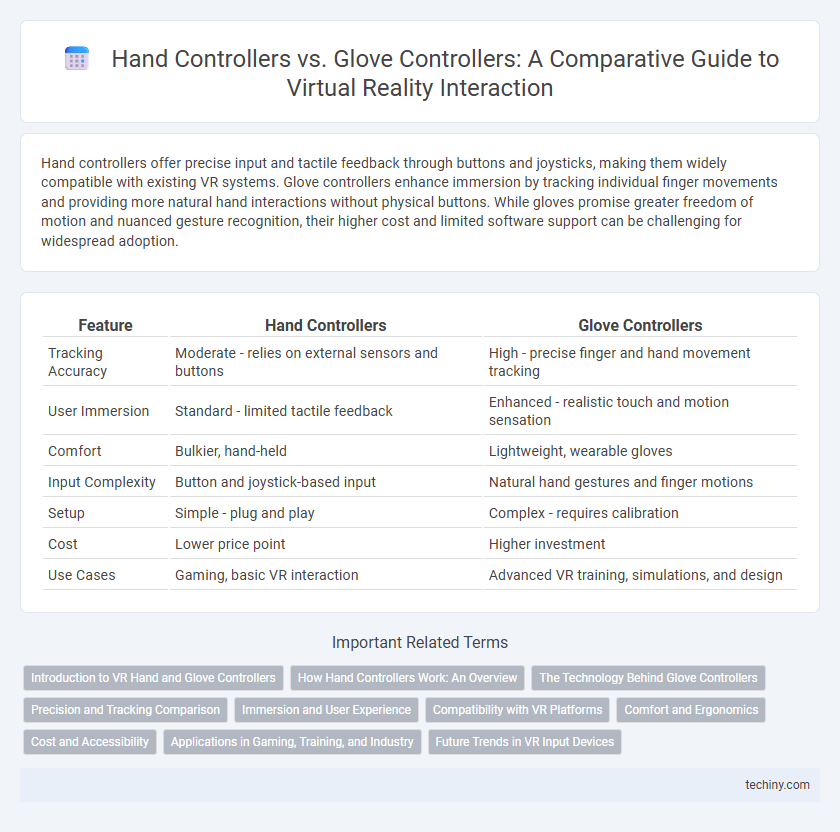Hand controllers offer precise input and tactile feedback through buttons and joysticks, making them widely compatible with existing VR systems. Glove controllers enhance immersion by tracking individual finger movements and providing more natural hand interactions without physical buttons. While gloves promise greater freedom of motion and nuanced gesture recognition, their higher cost and limited software support can be challenging for widespread adoption.
Table of Comparison
| Feature | Hand Controllers | Glove Controllers |
|---|---|---|
| Tracking Accuracy | Moderate - relies on external sensors and buttons | High - precise finger and hand movement tracking |
| User Immersion | Standard - limited tactile feedback | Enhanced - realistic touch and motion sensation |
| Comfort | Bulkier, hand-held | Lightweight, wearable gloves |
| Input Complexity | Button and joystick-based input | Natural hand gestures and finger motions |
| Setup | Simple - plug and play | Complex - requires calibration |
| Cost | Lower price point | Higher investment |
| Use Cases | Gaming, basic VR interaction | Advanced VR training, simulations, and design |
Introduction to VR Hand and Glove Controllers
VR hand controllers provide precise input through buttons and joysticks, allowing users to interact with virtual environments using physical grips and gestures. Glove controllers offer advanced motion tracking by capturing individual finger movements, enabling more natural and immersive hand interactions within VR. Both technologies play crucial roles in enhancing user experience by translating real-world hand motions into the virtual space.
How Hand Controllers Work: An Overview
Hand controllers in virtual reality use motion sensors, accelerometers, and gyroscopes to track hand movements and translate them into digital actions, providing precise positional data. These devices often include buttons and triggers to simulate interaction with virtual objects, enabling users to perform complex gestures with tactile feedback. Hand controllers wirelessly connect with the VR system, allowing real-time tracking and immersive control within virtual environments.
The Technology Behind Glove Controllers
Glove controllers utilize advanced sensor arrays, including flex sensors, IMUs (Inertial Measurement Units), and haptic feedback modules, to accurately track finger and hand movements in virtual reality environments. These sensors capture precise motion data, allowing for more natural and intuitive interactions compared to traditional hand controllers that rely on button presses and limited spatial tracking. The integration of tactile feedback in glove controllers enhances immersion by simulating the sense of touch, bridging the gap between virtual and physical experiences.
Precision and Tracking Comparison
Hand controllers in virtual reality provide reliable tracking with built-in sensors and buttons, offering intuitive interaction through physical haptics and standardized input layouts. Glove controllers utilize advanced finger-tracking technology and flexible sensors to enable more precise, natural hand movements and detailed gestures, enhancing immersion with high-fidelity motion capture. While hand controllers excel in consistent positional tracking and ease of use, glove controllers outperform in fine motor accuracy and realistic tactile feedback, making them ideal for applications requiring intricate manipulation.
Immersion and User Experience
Hand controllers offer precise tracking and intuitive button layouts, enhancing user control and comfort in virtual reality environments. Glove controllers provide a more natural and immersive experience by capturing detailed finger movements and tactile feedback, closely mimicking real hand interactions. The choice between the two impacts immersion, with glove controllers delivering higher realism at the expense of complexity and cost, while hand controllers balance ease of use and functionality.
Compatibility with VR Platforms
Hand controllers offer broad compatibility with most major VR platforms such as Oculus Quest, HTC Vive, and PlayStation VR, making them the standard choice for immersive experiences. Glove controllers, while providing enhanced dexterity and natural hand movements, often have limited platform support and require specific software integrations for optimal performance. Developers and users must weigh the trade-offs between universal compatibility and advanced interaction capabilities when choosing between these input devices.
Comfort and Ergonomics
Hand controllers in virtual reality offer a familiar and ergonomic design with buttons and triggers positioned for ease of use, supporting extended sessions with minimal strain. Glove controllers provide a more natural, immersive experience by mimicking real hand movements and distributing pressure evenly across the fingers and palm, enhancing comfort through customizable fit and breathable materials. Both types prioritize reducing hand fatigue, but glove controllers excel in personalized ergonomics and tactile feedback.
Cost and Accessibility
Hand controllers for virtual reality are generally more affordable, ranging from $50 to $300, making them widely accessible to a broad user base. Glove controllers, while offering enhanced immersion through finger tracking and tactile feedback, often cost between $200 and $1,000, limiting their accessibility to enthusiasts and professionals. The lower price point and compatibility of hand controllers with most VR systems contribute to their dominance in consumer markets.
Applications in Gaming, Training, and Industry
Hand controllers in virtual reality offer precise button inputs and haptic feedback, making them ideal for gaming environments requiring fast interactions and accurate control. Glove controllers provide more natural hand movements and finger tracking, enhancing immersive training simulations and industrial applications that demand fine motor skills or detailed manipulation. In industry, glove controllers improve ergonomics and safety by replicating complex hand gestures, while hand controllers remain popular in gaming for their intuitive design and ease of use.
Future Trends in VR Input Devices
Hand controllers will continue evolving with improved precision, haptic feedback, and ergonomic designs that enhance immersive VR experiences. Glove controllers are gaining traction for their ability to capture natural finger movements and provide tactile sensations, promising finer interaction and more intuitive control. Future VR input devices will likely integrate advanced sensors and AI-driven adaptability to offer seamless, realistic hand presence in virtual environments.
Hand Controllers vs Glove Controllers Infographic

 techiny.com
techiny.com